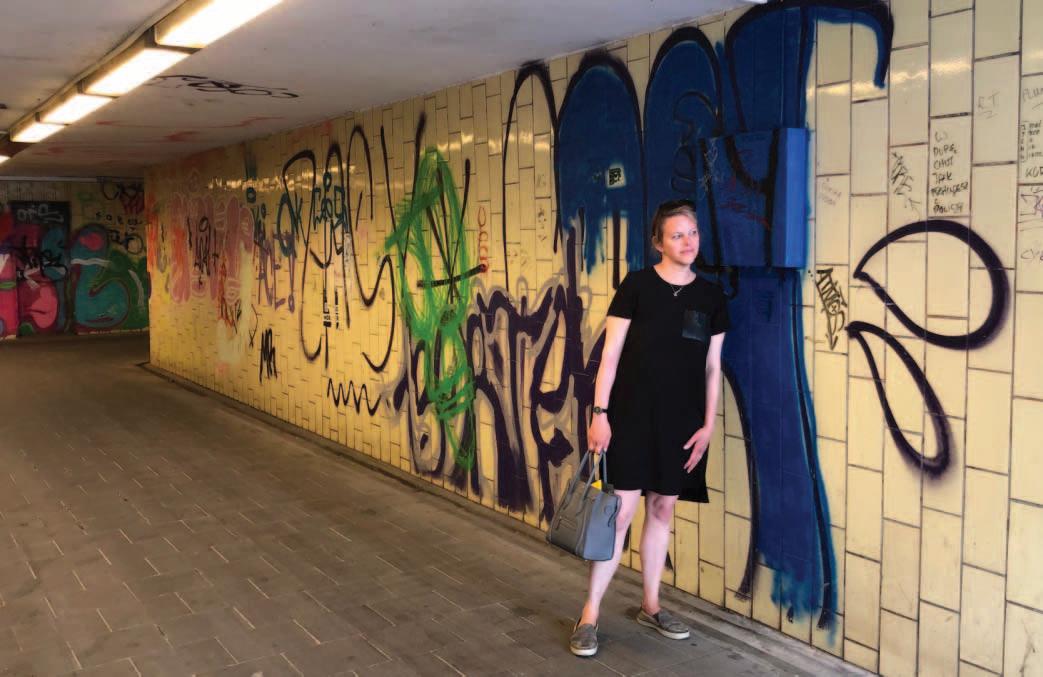
3 minute read
Reimagining contemporary art at WAM
Claire Whitner, Director of Curatorial Affairs and James A. Welu Curator of European Art listening to an underground sound installation by Sudanese artist Khalid Albaih at documeta in Kassel, Germany, on July 2022. Photo: Samantha Cataldo
Curators of contemporary art have the unique privilege of working with artists to develop and exhibit their work, bringing their creative vision to the public, and helping incorporate the visual arts into the broader culture. What is most exciting to me about working with living artists and curating the art of our time is that everything is in constant flux. Established ideas are being challenged just as frequently as new ideas are brought forth. As my colleagues and I work to reinvigorate the presentation of contemporary art at WAM, we are keenly aware that Worcester and the world around it is changing at a rapid pace. This should be reflected in the art WAM presents. As a recent Worcester transplant, I am researching and experiencing what arts and culture in Worcester has been, is, and can be. A crucial part of my job is to help connect WAM with national and global arts culture. One of the key ways that artists, curators, and others in our field connect on these important topics is through international art fairs and events. Due to pandemic rescheduling, two such events fortuitously overlapped in the summer of 2022: La Biennale di Venezia (Venice, Italy) and documenta (Kassel, Germany). This presented the perfect opportunity to conduct research by visiting these very different but equally influential events. Known as the “Olympics of the art world,” the Biennale began in 1895 and is considered the preeminent international art event. Numerous artists in WAM’s collection have been award-winners at this sprawling and prestigious event, including Christian Marclay (2011), Bruce Nauman (2009), Louise Bourgeois (1999), Nam June Paik (1993), and Henri Matisse (1950). Taking place every five years, documenta began in 1955 as Germany sought to reconnect with the international art world following World War II. It has since become known as highly experimental and influential, a harbinger of artworld trends, and a place for critical discourse. Art is installed throughout the city, from museums to underground tunnels to 18th-century palaces. This iteration of the Biennale was organized by New York-based curator Cecilia Alemani around a surrealist theme that posits “a magical world where life is constantly re-envisioned through the prism of the imagination. … a world where everyone can change, be transformed, become something or someone else.”1 The rigorously researched exhibition included historical material alongside contemporary work that centered the imaginations of BIPOC (Black, Indigenous and People of Color), women, nonbinary people, and other marginalized groups. This year’s documenta was curated by an Indonesian artist collective, ruangrupa, who fittingly organized the exhibition based on the principles of collectivity, communal building, and sharing of resources.2 The participating artists came from highly diverse backgrounds, and the work presented was wide-ranging and took non-traditional forms, manifesting most often in community-centered or collaborationdriven makerspaces and gathering places. The common thread that was most relevant to the work we are committed to at WAM was the emphasis on celebrating diverse viewpoints and centering community. There was an ethos that art is not just to be looked at, but experienced, becoming an integral part of one's life. This is front of mind as we plan future presentations of the art of our time alongside WAM’s superb historic collections. We must consider how contemporary art and artists can speak to issues that are most relevant to the many communities that we serve. At the same time, we want to present art that inspires conversation, encourages respite, and increases joy. I look forward to working with WAM’s various stakeholders to bring these experiences to fruition and further WAM’s mission to connect people, communities, and cultures through the experience of art. —Samantha Cataldo, Associate Curator of Contemporary Art
Samantha Cataldo joined WAM as Associate Curator of Contemporary Art in May 2022, bringing to the Museum her specialized expertise in contemporary art and commitment to community engagement, accessibility, and diversity. Cataldo graduated from Providence College with a degree in Art History and from Case Western Reserve University with a master’s degree in Art History and Museum Studies. Prior to coming to WAM, she was the Koch Curatorial Fellow for deCordova Sculpture Park and Museum and Senior Curator of Contemporary Art at the Currier Museum of Art.
1 Biennale Arte 2022 | Biennale Arte 2022: The Milk of Dreams (labiennale.org) 2 documenta fifteen (documenta-fifteen.de)










